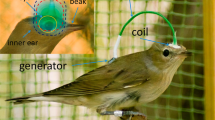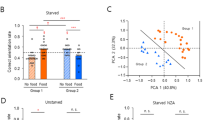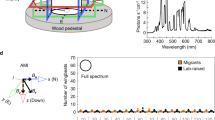Abstract
Although magnetic fields can influence biological systems, including those of man and other vertebrates1–5, no central nervous structure has been identified that might be involved in their detection. From a theoretical point of view, the pineal organ might be such a structure for the following reasons: (1) It is involved in the regulation of circadian rhythms6 and is thus essential for migratory restlessness (‘Zugunruhe’)7. Orientation at that time can be altered by an artificial magnetic field (MF) with a direction differing by 90° from that of the Earth. Circadian rhythms can be inhibited from phase shifting by compensation of the Earth's MF and can be influenced by an artificial MF8. (2) The pineal organ is strongly dependent on its sympathetic innervation6 and the sympatho-adrenergic system as a whole is sensitive to magnetic stimuli9. (3) The pineal organ is a light-sensitive time-keeping organ10,11 and could form part of a combined compass–solar-clock system, which has been postulated for maintaining orientation in birds12. We have therefore investigated the effect of a MF on electrophysiological activity of the guinea pig pineal organ, which is a useful system for such studies on individual cells11,13. We report here that activity was depressed by an induced MF and restored when the MF was inverted.
This is a preview of subscription content, access via your institution
Access options
Subscribe to this journal
Receive 51 print issues and online access
$199.00 per year
only $3.90 per issue
Buy this article
- Purchase on Springer Link
- Instant access to full article PDF
Prices may be subject to local taxes which are calculated during checkout
Similar content being viewed by others
References
Barnothy, M. F. (Plenum New York, 1964).
Barnothy, M. F. Vol. 2 (Plenum, New York, 1969).
Markl, H. in Biophysik (eds Hoppe, W., Lohman, W., Markl, H.& Ziegler, H.) (Springer, Berlin, 1977).
Martin, H. & Lindauer, M. Fortschr. Zool. 21, 211–228 (1973).
Martin, H. & Lindauer, M. J. comp. Physiol. 122, 145–187 (1977).
Wurtman, R. J., Axelrod, J. & Kelly, D. E. The Pineal (Academic, New York, 1968).
McMillan, J. P. J. comp. Physiol. 79, 105–112 (1972).
Brown, F. A. & Sciw, K. M. J. interdisciplinary Cycle Res. 9, 137–145 (1978).
Sakharova, S. A. Biol. Nauki 19, 40–44 (1976).
Binkley, S. A., Riebman, J. B. & Reilly, K. B. Science 202, 1198–1201 (1978).
Semm, P. & Vollrath, L. J. neural Transmission 47, 181–190 (1980).
Walcott, C. J. exp. Biol. 70, 105–123 (1977).
Semm, P. & Vollrath, L. Neurosci. Lett. 12, 93–96 (1979).
Reiter, R. J. Rev. Physiol. 35, 305–328 (1973).
Turek, F. W. Science 194, 1441–1443 (1976).
Kappers, J. A. Z. Zellforsch. mikrosk. Anat. 52, 163–215 (1960).
Demmel, U., Höck, A., Kasparek, K. & Feinendegen, L. E. in Nuclear Activation Techniques in the Life Sciences, 193–203 (International Atomic Energy Agency, Vienna, 1979).
Krstić, R. Cell Tissue Res. 174, 129–137 (1976).
Frankel, R. B., Blakemore, R. P. & Wolfe, R. S. Science 203, 1355–1356 (1979).
Leask, M. J. M. Nature 267, 144–145 (1977).
Collin, J. P. Ciba Fdn Symp. 79–120 (1971).
Moore, R. Y., Heller, A., Wurtman, R. J. & Axelrod, J. Science 155, 220–223 (1967).
Author information
Authors and Affiliations
Rights and permissions
About this article
Cite this article
Semm, P., Schneider, T. & Vollrath, L. Effects of an Earth-strength magnetic field on electrical activity of pineal cells. Nature 288, 607–608 (1980). https://doi.org/10.1038/288607a0
Received:
Accepted:
Issue Date:
DOI: https://doi.org/10.1038/288607a0
This article is cited by
-
Magnetoreception in plants
Journal of Plant Research (2005)
-
Towards the neural basis of magnetoreception: a neuroanatomical approach
Naturwissenschaften (2005)
-
Role of the epiphysis in organization of the infradian rhythmicity of physiological systems
Neurophysiology (1999)
Comments
By submitting a comment you agree to abide by our Terms and Community Guidelines. If you find something abusive or that does not comply with our terms or guidelines please flag it as inappropriate.



